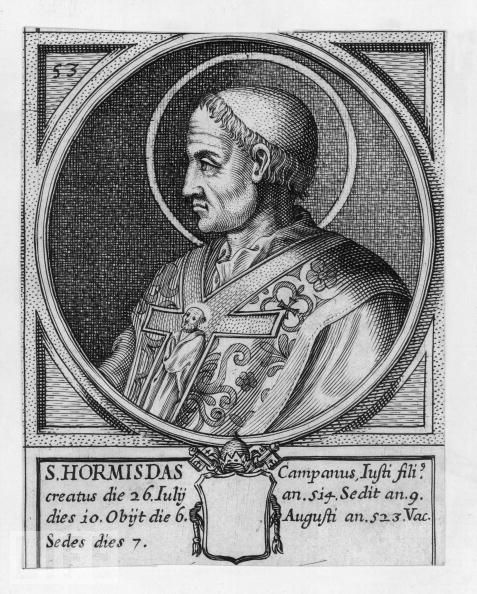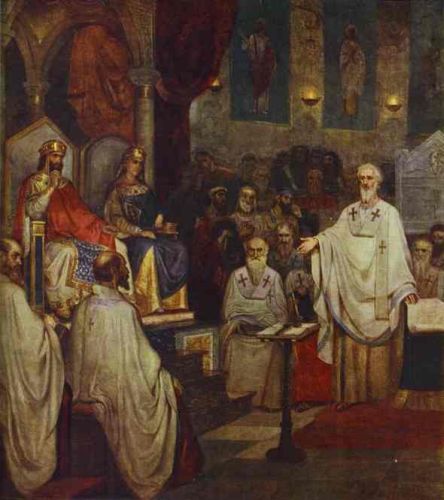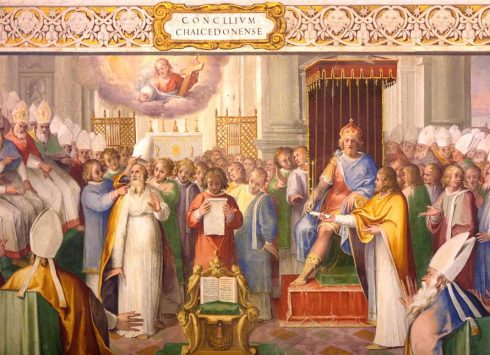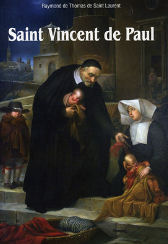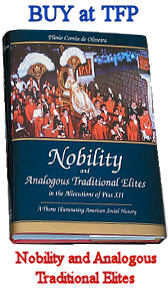Pope St. Hormisdas
Date of birth unknown, elected to the Holy See, 514; died at Rome, 6 August, 523.
This able and sagacious pontiff belonged to a wealthy and honourable family of Frosinone (Frusino) in the Campagna di Roma (Latium). Before receiving higher orders he had been married; his son became pope under the name of Silverius (536–537).
Under Pope Symmachus (498–514) Hormisdas held the office of deacon of the Roman Church and during the schism of Laurentius he was one of the most prominent clerical attendants of Symmachus. He was notary at the synod held at St. Peter’s in 502, and Ennodius of Pavia, with whom he was on friendly terms, expressed the conviction that this Roman deacon, so eminent for piety, wealth, and distinguished birth, would occupy the See of Rome [Ennodii opera, ed. Vogel (Berlin, 1885), 287, 290].
The day after the funeral of Symmachus (20 July, 514) Hormisdas was chosen and consecrated his successor; there is no mention of divisions or disturbances at his election. One of the new pope’s first cares was to remove the last vestiges of the Laurentian schism in Rome, receiving back into the Church such of its adherents as had not already been reconciled. From the beginning of his pontificate the affairs of the Greek Church occupied his special attention. At Constantinople the Acacian schism, which had broken out in consequence of the “Henoticon” of the Emperor Zeno, and which had caused the separation of the Greek and Roman Churches, still held sway. The Emperor Anastasius (491–518), Zeno’s successor, maintained the “Henoticon”; he became more and more inclined towards Monophysitism, and persecuted the bishops who refused to repudiate the Council of Chalcedon. The three patriarchs, Macedonius of Constantinople, Elias of Jerusalem, and Flavianus of Antioch had been driven from their sees.
In the midst of this confusion a number of Eastern bishops appealed to Rome during the pontificate of Symmachus, in order that, by the restoration of unity in the Church, their positions might be strengthened and the progress of Monophysitism checked. Symmachus had required them to submit to the condemnation of Acacius, but the Orientals were not ready for this step. Taking advantage of the discontent aroused against Anastasius by his Monophysite tendencies, Vitalian of Lower Moesia, a commander in the army, led a revolt against him. Vitalian demanded, on the one hand, that his office of distribution of the grain for the troops should be restored to him, and, on the other, that the Council of Chalcedon should be recognized and the unity with Rome re-established. He gained numerous adherents and appearing before Constantinople at the head of a large army, defeated the emperor’s nephew, Hypatius; upon this Anastasius was obliged to negotiate with him. One of the terms of Vitalian’s submission was that the emperor should take an oath to convene a synod at Heraclea in Thrace, invite the pope to attend it, and submit to his arbitration the dispute about the See of Constantinople and the other bishoprics in order by this means to restore the unity of the Church. Anastasius accordingly wrote to Hormisdas, 28 Dec., 514, inviting him to the synod on the first of July following. The letter had first to be submitted to Vitalian, whose representative accompanied the bearer to Rome. A second, less courteous communication, dated 12 Jan., was sent by Anastasius to the pope; this merely requested his good offices in the controversy. The emperor evidently wished to prolong the negotiations as he was not really willing to fulfill the promises he had made to Vitalian. The second letter reached Rome before the first one, and on 4 April Hormisdas answered it, expressing his delight at the prospect of peace, but at the same time defending the memory of his predecessors. The bearers of the emperor’s first letter arrived on 14 May. The pope guardedly carried on negotiations, convened a synod at Rome and wrote a letter to the emperor, dated 8 July, in which he announced the departure of an embassy for Constantinople. Meanwhile the two hundred bishops who had assembled on 1 July at Heraclea, separated without accomplishing anything.
The pope’s embassy to the imperial court consisted of two bishops, Ennodius of Pavia and Fortunatus of Catina, the priest Venantius, the deacon Vitalis, and the notary Hilarius. The letter of Hormisdas to the emperor, dated 1 Aug., 515, is still preserved; so also are the minute instructions given the legates with regard to the position they were to take. If the emperor agreed to the proposals made to him, the pope was ready, if necessary, to appear in person at a council. The pope further sent the formula of a confession of faith (regula fidei) for the Eastern bishops to sign. The embassy brought about no real results; Anastasius, without breaking off the negotiations, gave the envoys an evasive letter for Hormisdas. A new revolt of Vitalian was suppressed, and an imperial embassy, consisting of two high civil officials, came to Rome bringing a letter dated 16 July, 516, for the pope, and one dated 28 July, for the Roman Senate; the aim of the latter was to induce the senators to take a stand against Hormisdas. The senate, however, as well as King Theodoric, remained true to the pope, who saw through the emperor’s crafty manoeuvres. The answer of Hormisdas to the imperial letter was dignified and definite. Meanwhile an additional number of Scythian, Illyrian and Dardanian bishops had entered into relations with Rome, and several of them had also conferred with the papal legates in Constantinople upon the question of the reunion of the Churches. They now submitted to the condemnation of Acacius and signed the confession of faith (regula fidei) of Hormisdas, as did also the bishops of the province of Epirus, who were persuaded thereto by the Roman subdeacon Pullio. This confession of faith, which the pope sent to Constantinople to be signed by all bishops who reunited with the Latin Church, is known as the “Formula Hormisdae” and was repeatedly mentioned at the [ed. note: First] Vatican Council. It begins with the words: “Prima salus est, regulam rectae fidei custodire et a constitutis Patrum nullatenus deviare. Et quia non potest Domini Nostri Jesu Christi praetermitti sententia dicentis: Tu es Petrus et super hanc petram aedificabo ecclesiam meam. Haec quae dicta sunt rerum probantur effectibus, quia in sede apostolica immaculata est semper Catholica conservata religio” (The first means of safety is to guard the rule of strict faith and to deviate in no way from those things that have been laid down by the Fathers. And indeed the words of Our Lord Jesus Christ: “Thou art Peter; and upon this rock I will build my church” [Matt., xvi, 18], cannot be disregarded; these things which were spoken are demonstrated by the results, for the Catholic religion has been preserved ever immaculate in the Apostolic See). Then follows the condemnation of Nestorius and the other heresiarchs and also of Acacius.
A second papal embassy consisting of Ennodius of Pavia and Bishop Peregrinus of Misenum had no better success. Anastasius even attempted to bribe the legates, in which, however, he was unsuccessful. They sought on the contrary to circulate secretly the pope’s letters summoning the people to reunite with the Roman Church. When the emperor heard of it he had them brought out of the city by a private gate to the seashore, put on shipboard, and sent back to Italy. Then Anastasius, who had momentarily nothing to fear from Vitalian, wrote an insolent letter to Hormisdas dated 11 July, 517, breaking off the negotiations, and continued to persecute the advocates of union with Rome. On 9 July, 518, he died very suddenly in the midst of a terrible storm. Shortly before that date Timotheus, the heretical Patriarch of Constantinople, had also passed away.  The Emperor Justin I (518–527), who succeeded, was an orthodox Christian. The people of Constantinople insisted that the new Patriarch John should anathematize the Monophysite heresy, recognize the definition of Chalcedon, and reunite the Greek Church with Rome. A synod, held at Constantinople, concurred in these views and an imperial envoy departed for Rome to entreat the pope on behalf of the emperor, the latter’s nephew Justinian, and the patriarch to come in person to the Orient, or send a legate for the purpose of re-establishing the unity of the Church. Hormisdas appointed the Bishops [Saint] Germanus [of Capua] and John, a priest Blandus, two deacons, Felix and Dioscurus, and a notary, Peter. They had the same instructions and confession of faith which were given the legates of 515. The embassy was received in Constantinople with great splendour. All the demands of the pontiff were conceded; the name of the condemned Patriarch Acacius as well as the names of the Emperors Anastasius and Zeno were stricken from the church diptychs, the Patriarch John accepted the formula of Hormisdas. On Holy Thursday, 28 March, 519, in the cathedral of Constantinople in presence of a great throng of people, the reunion of the Greek Church with Rome was ratified in the most solemn manner. The greater number of the Eastern and Greek bishops approved and signed the formula of Hormisdas. At Antioch an orthodox patriarch was chosen to replace the heretical Severus.
The Emperor Justin I (518–527), who succeeded, was an orthodox Christian. The people of Constantinople insisted that the new Patriarch John should anathematize the Monophysite heresy, recognize the definition of Chalcedon, and reunite the Greek Church with Rome. A synod, held at Constantinople, concurred in these views and an imperial envoy departed for Rome to entreat the pope on behalf of the emperor, the latter’s nephew Justinian, and the patriarch to come in person to the Orient, or send a legate for the purpose of re-establishing the unity of the Church. Hormisdas appointed the Bishops [Saint] Germanus [of Capua] and John, a priest Blandus, two deacons, Felix and Dioscurus, and a notary, Peter. They had the same instructions and confession of faith which were given the legates of 515. The embassy was received in Constantinople with great splendour. All the demands of the pontiff were conceded; the name of the condemned Patriarch Acacius as well as the names of the Emperors Anastasius and Zeno were stricken from the church diptychs, the Patriarch John accepted the formula of Hormisdas. On Holy Thursday, 28 March, 519, in the cathedral of Constantinople in presence of a great throng of people, the reunion of the Greek Church with Rome was ratified in the most solemn manner. The greater number of the Eastern and Greek bishops approved and signed the formula of Hormisdas. At Antioch an orthodox patriarch was chosen to replace the heretical Severus.
In the midst of all this activity for the establishment of peace a new quarrel broke out, which turned upon the formula: “One of the Trinity was crucified”. It was promulgated at Constantinople in 519 by John Maxentius and numerous Scythian monks who were upheld by Justinian (Theopaschite controversy). The patriach and the pope’s legates opposed the demand that this formula should be embodied as a dogma of the Church. The monks then proceeded to Rome where they caused some trouble; they also addressed the African bishops then residing in Sardinia. In 521 Hormisdas pronounced that the formula in question, although not false, was dangerous because it admitted of a false interpretation; that the Council of Chalcedon needed no amendment. About this time the African Bishop Possessor, at the instigation of some African monks, appealed to the pope for information regarding the Church’s attitude towards the Bishop of Riez, Provence, whose Semipelagian views coloured his writings. In his reply Hormisdas severely rebuked the quarrelsome spirit of these monks. He did not forbid the reading of the works of Faustus, but decided that what was good in them should be preserved and what was contrary to the doctrine of the Church should be rejected.
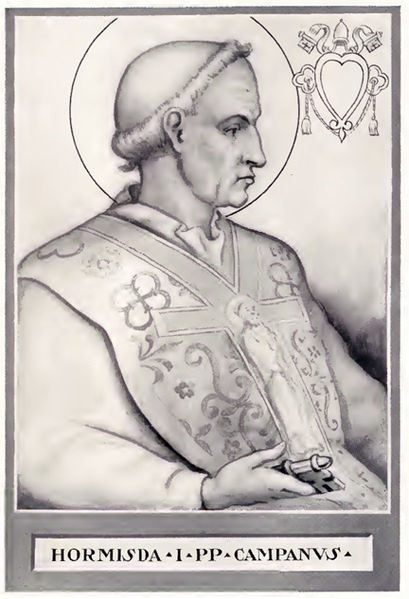 Hormisdas caused a Latin translation of the canons of the Greek Church to be prepared by Dionysius Exiguus and issued a new edition of the Gelasian “Decretum de recipiendis Libris”. He sent letters to several bishops in Spain and Gaul on ecclesiastical matters and gave directions regarding church administration. His relations with Theodoric were amicable. The “Liber Pontificalis” enumerates valuable gifts presented to St. Peter’s by this king as well as by the Emperor Justin.
Hormisdas caused a Latin translation of the canons of the Greek Church to be prepared by Dionysius Exiguus and issued a new edition of the Gelasian “Decretum de recipiendis Libris”. He sent letters to several bishops in Spain and Gaul on ecclesiastical matters and gave directions regarding church administration. His relations with Theodoric were amicable. The “Liber Pontificalis” enumerates valuable gifts presented to St. Peter’s by this king as well as by the Emperor Justin.
Shortly before his death the pope received tidings that Thrasamund the Vandal King of Northern Africa had died (523), and that the severe persecution of Catholics in that region had consequently ceased. Hormisdas was buried at St. Peter’s. The text of his epitaph has been preserved (De Rossi, “Inscriptiones Christianae urbis Romae”, II, 130).
Thiel, ed., Epistolae Romanorum Pontificum, I (Braunsberg, 1868), 739 sqq.; Duchesne ed., Liber Pontificalis, I, 269 sqq.; Gunther in Sitzungsberichte der Wiener Akademie, CXXVI (1892), xi; Langen, Geschichte der römischen Kirche, II (Bonn, 1885), 250 sqq.; Grisar, Geschichte Roms und der Papste, I, passim; Schnurer, Der politische Stellung des Papsttums zur Zeit Theodorichs in Historisches Jahrbuch, II (1889), 253 sqq.; Pfeilschifter, Der Ostgotenkonig Theoderich und die katholische Kirche in Kirchengesch, Studien, III (Munster, 1869) i-ii, 138 sqq.; Hefele, Konziliengeschichte, 2nd ed., II, 671 sqq., 692 sqq.
J.P. KIRSCH (Catholic Encyclopedia)
________________________
Also of interest:
June 20 – The Pope Who Was the Son of Another Pope, Also a Saint
